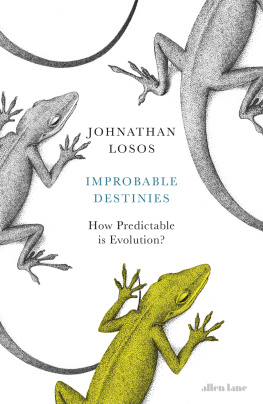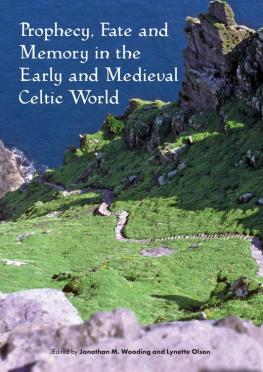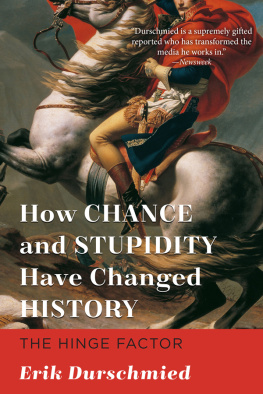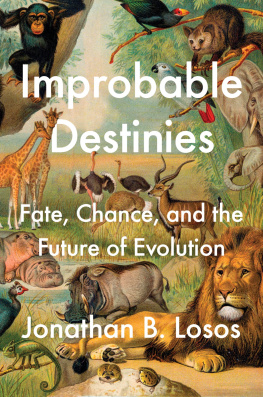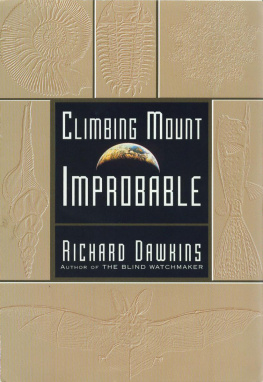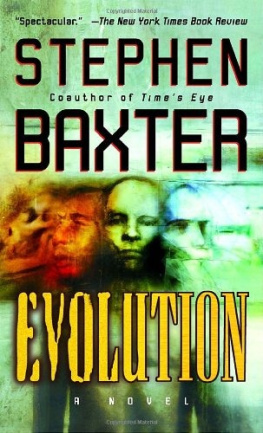Jonathan Losos - Improbable Destinies: Fate, Chance, and the Future of Evolution
Here you can read online Jonathan Losos - Improbable Destinies: Fate, Chance, and the Future of Evolution full text of the book (entire story) in english for free. Download pdf and epub, get meaning, cover and reviews about this ebook. year: 2017, publisher: Penguin Books Ltd, genre: Religion. Description of the work, (preface) as well as reviews are available. Best literature library LitArk.com created for fans of good reading and offers a wide selection of genres:
Romance novel
Science fiction
Adventure
Detective
Science
History
Home and family
Prose
Art
Politics
Computer
Non-fiction
Religion
Business
Children
Humor
Choose a favorite category and find really read worthwhile books. Enjoy immersion in the world of imagination, feel the emotions of the characters or learn something new for yourself, make an fascinating discovery.
- Book:Improbable Destinies: Fate, Chance, and the Future of Evolution
- Author:
- Publisher:Penguin Books Ltd
- Genre:
- Year:2017
- Rating:3 / 5
- Favourites:Add to favourites
- Your mark:
- 60
- 1
- 2
- 3
- 4
- 5
Improbable Destinies: Fate, Chance, and the Future of Evolution: summary, description and annotation
We offer to read an annotation, description, summary or preface (depends on what the author of the book "Improbable Destinies: Fate, Chance, and the Future of Evolution" wrote himself). If you haven't found the necessary information about the book — write in the comments, we will try to find it.
Jonathan Losos: author's other books
Who wrote Improbable Destinies: Fate, Chance, and the Future of Evolution? Find out the surname, the name of the author of the book and a list of all author's works by series.
Improbable Destinies: Fate, Chance, and the Future of Evolution — read online for free the complete book (whole text) full work
Below is the text of the book, divided by pages. System saving the place of the last page read, allows you to conveniently read the book "Improbable Destinies: Fate, Chance, and the Future of Evolution" online for free, without having to search again every time where you left off. Put a bookmark, and you can go to the page where you finished reading at any time.
Font size:
Interval:
Bookmark:



UK | USA | Canada | Ireland | Australia
India | New Zealand | South Africa
Allen Lane is part of the Penguin Random House group of companies whose addresses can be found at global.penguinrandomhouse.com.

First published in the United States of America by Riverhead Books an imprint of Penguin Random House LLC 2017
First published in Great Britain by Allen Lane 2017
Copyright Jonathan B. Losos, 2017
Illustration credits: copyright by David Tuss
The moral right of the author has been asserted
Cover illustration by Calie Mee
ISBN: 978-0-241-20194-7

discover more stories like this at Penguin.co.uk
To my wife, Melissa Losos, and my parents, Joseph and Carolyn Losos, for their love and support
Like many children, I went through a dinosaur phase. I was legendary at nursery school for showing up every day with my basket full of plastic dinosaurs: Allosaurus, Stegosaurus, Ankylosaurus, Tyrannosaurus rex. I had em all, or at least all of the twenty or so species available back then (kids today have it so much better).
Unlike most kids, I never grew out of the phase. I still have my toy dinos, many more now; I still know their names, can even still pronounce Parasaurolophus (pair-uh-soar-ahl-oh-fuss). But my interests have shifted to living reptiles: snakes, turtles, lizards, and crocodilians.
To a large extent, this shift was prompted by a rerun of the old TV show Leave It to Beaver, specifically the episode in which Wally and the Beave buy a mail-order baby alligator and hide it in the bathroom. Needless to say, when Minerva the housekeeper finds it, hilarity ensues. Thinking that this was a great idea and knowing that pet stores in those days (the early 1970s) sold baby caimans, the Central and South American version of the alligator, I petitioned my mother. Not being the sort of woman who likes to say no, she suggested we contact a family friend, Charlie Hoessle, the deputy director of the Saint Louis Zoo, My mother was stuck, and soon our basement was full of all manner of reptile. I was on my way to my own career in the field.
At the same time that I was tending my scaly charges, I was also an avid reader of the monthly magazine Natural History, put out by the American Museum of Natural History in New York. A highlight of every issue was the column This View of Life by the brilliant and erudite Harvard paleontologist Stephen Jay Gould. Its name lifted from the closing sentence of Darwins On the Origin of Species, the column regularly explored Goulds heterodox ideas about the evolutionary process, often stressing the indeterminate and unpredictable nature of evolution. Elegantly written and mixing in vignettes from history, architecture, and baseball, Gould presented a compelling case for his worldview.
When I was accepted to Harvard in 1980, I looked forward to learning from the great man himself in his modestly entitled non-majors course, The History of Earth and of Life. And fascinating he was, as engaging in person as he was in print. But the faculty member who made the greatest impression on me was Ernest Williams, the Curator of Herpetology at Harvards Museum of Comparative Zoology (the position I now hold). An imperious elder scientist, he nonetheless was very welcoming to a young upstart with an interest in reptiles. Soon I found myself studying the particular type of lizards that had been the focus of his lifes work.
Small, usually green or brown, with sticky pads on their toes and an extensible flap of colorful skin under their throats, anole lizards are photogenic and captivating in their antics. But what has shot them to fame in scientific circles is their evolutionary exuberance. Four hundred species are known, and more are being discovered every year, making Anolis one of the largest genera of vertebrate animals. This immense diversity is accomplished by great local richnessas many as a dozen or more co-occurring speciescombined with regional endemicity, most species being limited to a single island or small part of the tropical American mainland.
In the 1960s, Williams graduate student Stan Rand documented that anole species coexist by adapting to different parts of the habitat, some living high in the tree, others in the grass or on twigs. Williams great insight was to realize that the same set of habitat specialists had evolved on each island in the Greater Antilles (Cuba, Hispaniola, Jamaica, and Puerto Rico). That is, the lizards had diversified independently, yet had evolved to divvy up the available habitats in almost exactly the same way on all four islands.
As an undergraduate, I worked on a small part of this story, conducting an honors research project on the interactions between two species in the Dominican Republic. I graduated and headed to a Ph.D. program in California, vowing never to work on these lizards again because everything important had already been discovered by Williams and his lab.
Ah, the navet of youth. As anyone whos done science knows, successful projects usually answer one question, but lead to three new ones. It took me two years of graduate school and a dozen failed projects, but I finally realized island anoles are a perfect group for studying how evolutionary diversification occurs.
So I spent four years traipsing through the Caribbean, climbing trees, catching lizards, and sipping the occasional pia colada. And by the end, I had shown, using the latest analytical techniques, that Williams was exactly right. Anatomically and ecologically very similar species had evolved independently on the different islands. Moreover, my studies of biomechanicshow the lizards run, jump, and clingrevealed the adaptive basis for anatomical variation, explaining why features such as long legs or big toepads evolved for species using particular parts of the habitat.
The ink was barely dry on my dissertation when Wonderful Life: The Burgess Shale and the Nature of History, arguably Stephen Jay Goulds greatest work, appeared in bookstores. I read it voraciously and found the argument persuasive. Evolutions path is quirky and unpredictable, he argued; replay lifes tape again and youd get a very different outcome.
But hold on. Goulds conceit of turning back the clock and replaying the evolutionary tape of life is impossible (at least in nature), but another way to test the repeatability of evolution would be to play the same tape in multiple locations. Arent Caribbean islands, each seeded with an ancestral anole lizard, essentially the same as replaying the tape of life? Assuming that the islands have more or less the same environments, doesnt this constitute a test of evolutionary repeatability?
Font size:
Interval:
Bookmark:
Similar books «Improbable Destinies: Fate, Chance, and the Future of Evolution»
Look at similar books to Improbable Destinies: Fate, Chance, and the Future of Evolution. We have selected literature similar in name and meaning in the hope of providing readers with more options to find new, interesting, not yet read works.
Discussion, reviews of the book Improbable Destinies: Fate, Chance, and the Future of Evolution and just readers' own opinions. Leave your comments, write what you think about the work, its meaning or the main characters. Specify what exactly you liked and what you didn't like, and why you think so.

